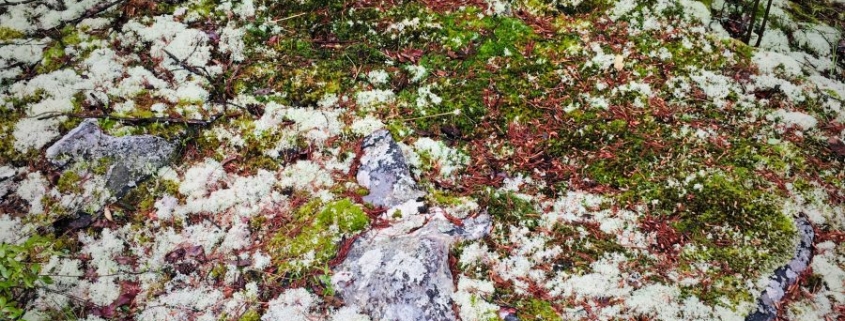Sandstone Glades at DeSoto State Park
One Photo Says it All!
I could begin and end this Post with just one photo — a full-color mosaic of life on a sandstone glade at DeSoto State Park:
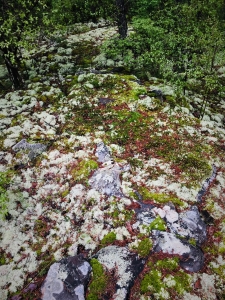
What is an Alabama Sandstone Glade?
Dr. R. Scott Duncan, professor of biology and urban environmental studies at Birmingham-Southern College, published Southern Wonder in 2013. Subtitled Alabama’s Surprising Biodiversity, his book chronicles Alabama’s rich floral and faunal life from the Gulf to the Tennessee Valley. Only four other states, all west of the Mississippi River, are more biologically diverse.
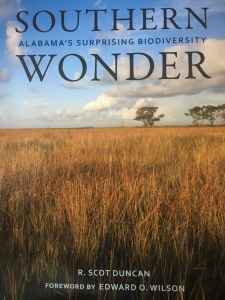
One of the enabling factors for our state’s life-richness is the many unique eco-sites across the state. Duncan describes among those unusual habitats glades:
“Glades are open ecosystems where bedrock exposure and extreme soil conditions keep trees away. They are rare in the Southeast, but Alabama has glades of sandstone, limestone, granite, and dolomite. All have thin, dry soils and provide little rooting space and few nutrients. These ecosystems harbor unusual plants that handle brutal extremes but cannot survive alongside more competitive plants dominating milder environments. Their adaptations for survival are manifold.”
Duncan offers that “very few sandstone glades survive in Alabama; most are in the Southern Table Plateaus…” Such glades serve as examples of “the Cumberland Sandstone Glades and Barrens ecosystem. Both are treeless, but glades have extremely thin soils or none whatsoever.” See Duncan’s wonderful book for more information, presented in an easy-to-read, welcoming prose, rich with science accessible and digestible to an interested layman. No self-respecting Alabama Nature-enthusiast should do without a copy of Southern Wonder!
As I’ve reported in a prior post, I visited DeSoto SP April 18-20: https://stevejonesgbh.com/2019/05/15/the-magic-of-waters-thunder-at-desoto-state-park/ . We found several sandstone glades at DeSoto, painted spectacularly with multiple hues deepened and intensified by the prior night’s frog-strangling cloudburst. Var-riotous (my new word combining var-iety and riotous profusion) lichens and mosses flourish in spring’s abundant moisture. What a joy it would be for a non-flowering plant specialist to drop to the knees with hand-lens and notebook to journal what lies unknown to my forester’s eye and mind. I can merely marvel at the beauty, magic, wonder, and awe of an other-worldly ecosystem.

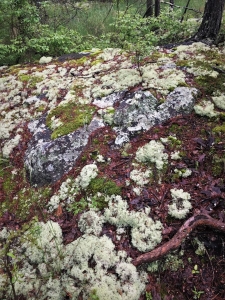
Duncan notes, “The shallow slopes of the Cumberland Plateau’s glades may be what allows them to support a more diverse flora.” Of one particular glade nearby, Duncan said, “Water seeps from the woodland margin at the top of the glade and slowly trickles across its surface. The water pools in scattered rounded depressions etched in the bedrock over millennia by the acidic groundwater. Such pooling is possible only because the slope is gentle.” His description matches perfectly what I observed below on the orange and blue trails Saturday morning:
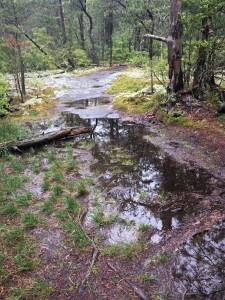

Whether spring-rain-sodden grasses (above) or thick pads and clumps of lichens and mosses, and a few shrubby trees, the site shouts impoverishment and harshness. I felt joy and privilege to witness the glades at full-glory, high tide, maximum esthetic register. A sandstone glade cathedral … a magic-carpet stroll through a rare ecosystem. Serendipity and fortuity blessed me with a naturalist’s winning lottery ticket!
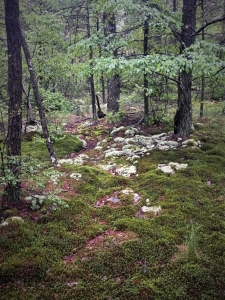
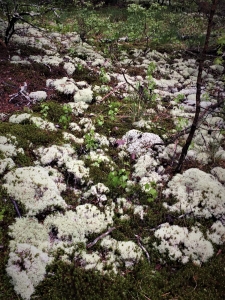
A Power-Ball jackpot of pure spiritual goodness cushioned with reindeer moss!
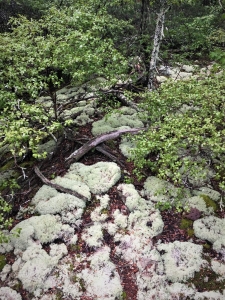
Duncan said of the spring-wet glades, “In the water are semiaquatic plants that grow for only a few weeks each spring. The most conspicuous is Elf Orpine, a small, bright-red succulent forming thick mats.” Again, Nature gifted me with the winning numbers. Well, actually DeSoto Naturalist Brittney Hughes picked the numbers, intentionally timing her invite for my visit to coincide with peak spring floral richness. The Elf Orpine (Diamorpha smallii) ceremoniously reached zenith for my visit.

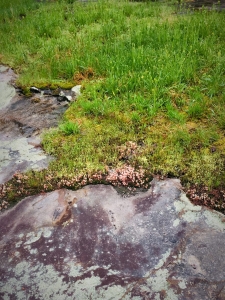
Such an incredible gift!
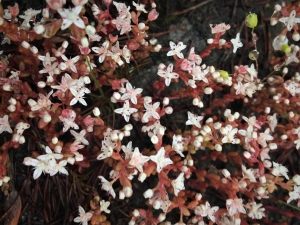
Duncan continued, “This layers of saturated, gritty soil sustains mosses, grasses, and wildflowers. Among the latter… gaudy Yellow Sunnybells display panicles of bright yellow flowers…” Again, my timing yielded sunnybells (Schoenolirion croceum) in full flower, as well as rich admixtures of mosses and grasses.
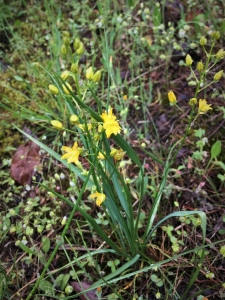
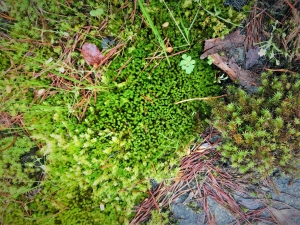
We found hill cane (Arundinaria appalachiana) along the trail near the glades. One internet source said, “hill cane, is a woody bamboo native to the Appalachian Mountains in the southeastern United States. The plant was elevated to the species level in 2006 based on new morphological and genetic information and was previously treated as a variety of Arundinaria tecta.” I am accustomed to seeing the more common cane in lowlands of central and southern Alabama.
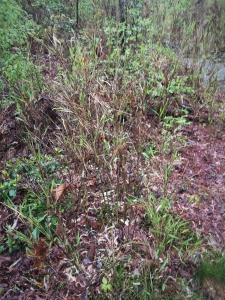
I had no clue as I listened to the overnight deluge, that hiking the following two days a DeSoto State Park would reveal multiple treasures, the Park’s sandstone glades among them. I am thankful that my first direct exposure to sandstone glades proved so fruitful. Again, for further insight to my DeSoto discoveries, see my earlier Blog Post on The Magic of Water’s Thunder at DeSoto State Park: https://stevejonesgbh.com/2019/05/15/the-magic-of-waters-thunder-at-desoto-state-park/
Also, watch for a subsequent Post (likely in June) on A Spring Day at DeSoto State Park focusing on the Park’s spring features beyond the tumbling waters and sandstone glades.
I learn so much on these sojourns into Nature. Writing these Posts and offering resultant reflections and lessons sharpen my powers of observation. I’ve often said that conversation demands a great deal of the engaged conversant. However, nothing requires so much of our mental capacity as writing. No, not the “labor” of writing. Instead, it is the concentration of believing, looking, seeing, and feeling demanded by my hikes, knowing that I must translate my woods-treks to these Posts. I suppose that is why I greet completion of each Post with relief, satisfaction, and no small measure of exhaustion. However, if I can win just one reader over to the side of the Earth stewardship angels, my labor is more than rewarded.
My efforts are driven by passion, purpose, and love of Earth. For many years I have observed, “People don’t care how much you know until they know how much you care.” I CARE. Although I aim to be scientifically correct, I am not intent upon showing you how much I know. Instead, I want you to know how much I care. Incidentally, the more writing I do, the more I realize that I know so very little, even as my CARE expands exponentially.
Thoughts and Reflections
I wrote my books Nature Based Leadership (2016), Nature-Inspired Learning and Leading (2017), and Weaned Seals and Snowy Summits: Stories of Passion for Place and Everyday Nature (2019; co-authored with Dr. Jennifer Wilhoit; Submitted to publisher May 31, 2019), as well as another one by me (single author) scheduled for 2020, Natural Elixir: Lifting Your Life through Nature’s Inspiration, to encourage all citizens to recognize and appreciate that every lesson for living, learning, serving, and leading is either written indelibly in or is powerfully inspired by Nature. Both published books are available on Amazon and other online sources.
Here are the three succinct lessons I draw from this Blog Post:
- Rare, isolated, and unusual ecosystems (like Alabama’s sandstone glades) provide vast windows for understanding and appreciating the peculiar mechanisms and wonder of Nature.
- To every time there is a season… in life and for each and every ecosystem.
- Know Nature’s multifarious seasons… and her times to every purpose under heaven.
Inhale and absorb Nature’s elixir. May Nature Inspire and Reward you!
Note: All blog post images created & photographed by Stephen B. Jones unless otherwise noted. Please circulate images with photo credit: “©2019 Steve Jones, Great Blue Heron LLC. All Rights Reserved.”
Another Note: If you came to this post via a Facebook posting or by an another route, please sign up now (no cost… no obligation) to receive my Blog Post email alerts: https://stevejonesgbh.com/contact/
And a Third: I am available for Nature-Inspired Speaking, Writing, and Consulting — contact me at steve.jones.0524@gmail.com
Reminder of my Personal and Professional Purpose, Passion, and Cause
If only more of us viewed our precious environment through the filters I employ. If only my mission and vision could be multiplied untold orders of magnitude:
Mission: Employ writing and speaking to educate, inspire, and enable readers and listeners to understand, appreciate, and enjoy Nature… and accept and practice Earth Stewardship.
Vision:
- People of all ages will pay greater attention to and engage more regularly with Nature… and will accept and practice informed and responsible Earth Stewardship.
- They will see their relationship to our natural world with new eyes… and will understand more clearly their Earth home.
Tagline/Motto: Steve (Great Blue Heron) encourages and seeks a better tomorrow through Nature-Inspired Living!
Alabama State Parks Foundation
I’ll remind you that I serve on the Foundation Board, in part because of my love of Nature and in recognition for my writing many prior Posts about visiting and experiencing the Parks. I urge you to take a look at the Foundation website and consider ways you might help steward these magical places: https://asparksfoundation.org/ Perhaps you might think about supporting the Parks System education and interpretation imperative, including initiatives related to rare and unusual Park ecosystems.

